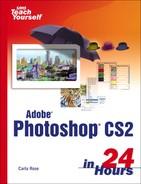Applying Masks
Masks can hide either a selected object or the background, and can be opaque or semitransparent. If the mask is totally transparent, it isn't masking anything. Masks—and channels, which you'll learn about later—are actually grayscale images. An opaque mask is black, a 50% transparent mask is 50% gray, and so on.
In Figure 12.1, I have a nice photo of a lighthouse that was shot on a cloudy day. (It's somewhere on the south coast of Nova Scotia, although I'm not sure where. Perhaps a Canadian reader will enlighten me.) To my eye, this would be more interesting if I could do something with that sky. The lighthouse and woods are accurate for color, as nearly as I can remember, so I don't want to change them. If I select just the sky, I can work on it without affecting the rest of the photo. Of course, that wire will have to come out at some point, but that's a job for another hour.
Figure 12.1. I've done my best to select the sky around the lighthouse and trees, so I can work on the background without disturbing them.

This is the most basic kind of masking. It's not always perfect, though. In Figure 12.2, you can see that the Lasso tool and Magic Wand didn't really give me a very accurate mask. The edges aren't very smooth, and there's a lot of the top of the lighthouse missing. What's needed is a way to edit the mask.
Figure 12.2. Up close, you can see that the selection isn't very accurate.

